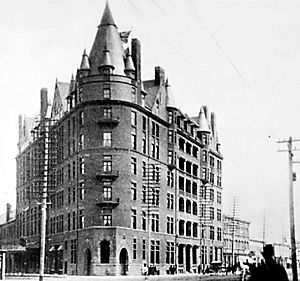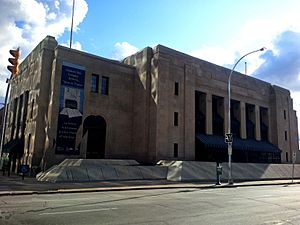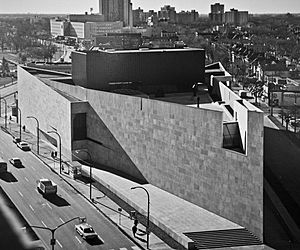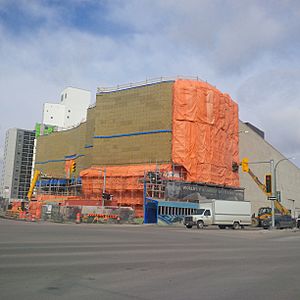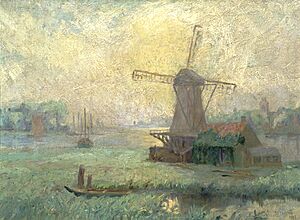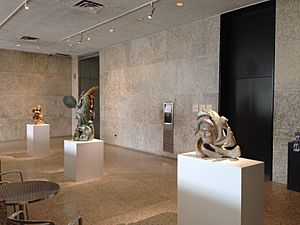Winnipeg Art Gallery facts for kids
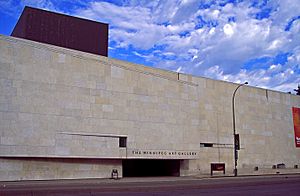
Winnipeg Art Gallery
|
|
| Established | 16 December 1912 |
|---|---|
| Location | 300 Memorial Boulevard, Winnipeg, Manitoba, Canada |
| Type | Art museum |
| Visitors | 160,000 (2007) |
| Architect | Gustavo da Roza (main building) Michael Maltzan (Qaumajuq) |
The Winnipeg Art Gallery (WAG) is an art museum located in Winnipeg, Manitoba, Canada. It has a huge collection of over 24,000 artworks. These include pieces by Canadian, Indigenous Canadian, and international artists. The WAG is also home to the world's largest collection of Inuit art. Besides showing its own collection, the museum also hosts many travelling art shows. The museum complex has a main building with 11,000 square metres (120,000 sq ft) of space. It also has the nearby Qaumajuq building, which is 3,700-square-metre (40,000 sq ft) big.
The museum as we know it today officially started in 1963. But its roots go back to the Winnipeg Museum of Fine Arts. This art museum opened to the public in 1912. It was started by the Winnipeg Development and Industrial Bureau. The bureau also opened the Winnipeg School of Arts in 1913. Both the museum and the school were run by the bureau until 1923. Then, they became their own organization called the Winnipeg Gallery and School of Arts. In 1926, the Winnipeg Art Gallery Association was created. This group helped the museum with its operations. The Winnipeg Gallery and School of Art closed in 1950. However, its art collection was loaned to the Winnipeg Art Gallery Association. This group continued to show the art.
In 1963, the Winnipeg Art Gallery Association officially became the Winnipeg Art Gallery. This was made possible by the Legislative Assembly of Manitoba. The museum moved to its current spot in September 1971. A special building was built for it, designed by Gustavo da Roza. In 2021, the museum opened the Qaumajuq building. This new building was designed by Michael Maltzan. It was built to house the museum's amazing Inuit art collection.
Contents
History of the Art Gallery
Early Art Galleries in Winnipeg
Winnipeg's first real art gallery opened in the old Manitoba Hotel. This hotel was built around 1892. A part of the hotel was set aside for an art studio. Cora Moore organized this art gallery. She started a Winnipeg branch of the Women's Art Association of Canada. She also created an art group for men. The first art show happened in February 1895. This gallery showed art from Manitoba, Toronto, Montreal, New York, London, and Paris. The art gallery closed when the Manitoba Hotel burned down in 1899.
People started trying to create another art museum in 1902. This was after the Manitoba Society of Artists was formed. Its members began to ask for a provincial art institution. In 1908, the Winnipeg branch of the Western Art Association also pushed for an art museum. They wanted it to show art from Manitoba and the rest of Canada.
The Gallery and School of Art
In April 1912, the first part of the Board of Trade building was finished. The Winnipeg Development and Industrial Bureau then announced plans for the second part. This plan included a space for an art museum. The museum was called the Winnipeg Museum of Fine Arts. It officially opened on December 16, 1912. The Mayor of Winnipeg Richard Deans Waugh and the Lieutenant Governor of Manitoba Douglas Cameron were there. The first show at the museum had 275 artworks from the Royal Canadian Academy of Arts.
Because the art museum was so successful, the bureau opened the Winnipeg School of Arts. It opened in the same building on June 21, 1913. The art school and museum were separate parts of the same organization. They were first controlled by the bureau. In April 1923, the organization became independent. It was officially named the Winnipeg Gallery and School of Art. This was done by the Legislative Assembly of Manitoba.
By the mid-1920s, the organization faced money problems. It had to stop most museum activities in 1926. The museum's art collection was held by the School of Art for safekeeping. In August 1926, the Winnipeg Art Gallery Association was formed. This group helped the museum with its operations. The gallery reopened on April 22, 1932. It was located in the western wing of the Civic Auditorium. This building is now the Manitoba Archives Building. The School of Art stayed in the Board of Trade building until it was torn down in 1935. The school then moved twice, in 1936 and 1938.
In June 1950, the Winnipeg Gallery and the School of Art officially closed. The School of Art became part of the University of Manitoba. The artworks collected for the old institution were loaned to the Winnipeg Art Gallery Association. This loan was for an "indefinite" time. The association continued to show the collection at the Civic Auditorium.
The Winnipeg Art Gallery Today
On May 6, 1963, the Winnipeg Art Gallery Association officially became the Winnipeg Art Gallery. This was done by the Legislative Assembly of Manitoba. In 1965, there were talks about moving the art gallery. However, the museum did not want to move to the Manitoba Centennial Centre. This centre also included the Centennial Concert Hall and the Manitoba Museum. The Winnipeg Art Gallery said that politicians were causing problems. They felt that different art groups were being set against each other.
In 1967, the museum bought a triangular piece of land. It was across from the Civic Auditorium. They held a competition for architects to design a new building. The new design meant tearing down several buildings on the site. These included an old service station and the Cinema Centre building. Work on the new museum building began in 1969.
The gallery moved to its current location in 1971. The building was designed by Canadian architect Gustavo Da Roza. The new building had more space for exhibits. It also allowed the museum's storage and conservation unit to be in the same building. Before, it was in a different location. The building cost about C$4.5 million to build. Funding came from the federal and provincial governments, private donations, and public fundraising. Princess Margaret, Countess of Snowdon officially opened the building on September 25, 1971.
In October 1995, the museum grew bigger. It bought the old Medical Mall building next to its main building. This space was used for the museum's art studio programs.
In 2012, the museum and the National Gallery of Canada made an agreement. For three years, works from the National Gallery's collection were shown at the WAG. In November 2015, the Government of Nunavut made a five-year loan agreement. They agreed with the Government of Manitoba to show Nunavut's collection of 8,000 artworks at the WAG. The Government of Nunavut collection started in 1999. It was first kept at the Prince of Wales Northern Heritage Centre in Yellowknife. Nunavut had planned to keep the collection in a special building in Iqaluit. However, those plans were later changed.
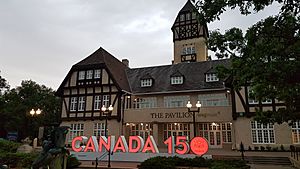
In June 2016, the museum opened a store called WAG@The Forks. It was at The Forks. This store was created to promote and sell Inuit art. It was a partnership between the Government of Nunavut and the Winnipeg Art Gallery. In September 2016, the museum and the Assiniboine Park Conservancy opened WAG@ThePark. This was at the Assiniboine Park Pavilion. Through this partnership, the museum organized exhibits in the building. Most of the art shown at WAG@ThePark came from the Conservancy's collection. Some Inuit works from the museum's own collection were also shown there.
In 2018, a lost painting by Alfred Munnings was found. It was in the Winnipeg Art Gallery's collection. The painting shows Brigadier General R.W. Paterson's horse, Peggy, during the First World War. It was lost after a Royal Academy of Arts exhibition in 1919. That show featured this painting and 43 other works by Munnings. The lost painting was found in the WAG's collection. This happened after the British National Army Museum asked for help finding it. They wanted to recreate the 1919 exhibition. The Winnipeg Art Gallery said the painting joined its collection in 1984. It was donated by Paterson's children.
The old Medical Mall building was torn down in 2017. This was to make room for a new building for the museum's Inuit art collection. This new building is called Qaumajuq. Construction began in May 2018. The groundbreaking ceremony in May 2018 included special Inuit traditions. These included lighting a qulliq, an Inuit drum dance, and throat singing. Qaumajuq cost about C$65 million to build. C$35 million came from the federal, provincial, and city governments. The rest came from public and private donations. When it opened, Qaumajuq was the first museum building in the world dedicated to Inuit art. Qaumajuq opened to the public on March 25, 2021.
In 2023, the museum started to remove the name of a former director, de:Ferdinand Eckhardt, from its entrance hall. This happened after reports about his past activities came out.
Museum Buildings and Grounds
The land where the Winnipeg Art Gallery stands today was bought in 1967. The museum's main building opened on this land on September 25, 1971. In 1995, the museum expanded its property. It bought the old Medical Mall building south of the main building. In 2017, the Medical Mall was torn down. This was to build Qaumajuq, a building focused on Inuit art. The main building and Qaumajuq are connected by a skyway.
The Main Building
The main building of the Winnipeg Art Gallery opened in September 1971. It was designed by Gustavo da Roza in a late-modernist style. During the design and building process, da Roza worked with Number Ten Architects. They helped with the architectural drawings and managing the project.
The outside of the building looks like an iceberg. It has a "triangular mass" shape. It is low to the ground and has almost no windows. The outer walls are sloped to reflect sunlight. They also have sharp, geometric angles. A part that sticks out from the main building forms the entrance. Most of the building was made from reinforced concrete. It is covered in Tyndall stone. Da Roza chose Tyndall stone to show the "character of the northern prairie environment." Tyndall stone is also used a lot inside the building. You can see it on the walls and floors, and in the lounges on the second floor.
The inside of the gallery was designed to protect the artworks. It has special systems to keep the temperature and humidity just right. Because of the building's angular shape, almost every room is a different shape. The inside of the building has 2,400 square metres (26,000 sq ft) of space for exhibits. Most of the art galleries are on the third floor. This floor also has a skylight from the rooftop garden. The mezzanine level has smaller exhibit spaces, the museum's library, and offices.
The ground level is called Ferdinand Eckhardt Hall. It is a large space covered in Tyndall stone. It has the museum's gift shop and art rental store. There is also a conservation lab, the main lobby, and a 320-seat auditorium. The museum's restaurant and access to the rooftop garden are on the fourth floor. The storage for its collections is in the basement. The total indoor area of the main building is 11,000 square metres (120,000 sq ft).
Qaumajuq Building
The museum property also includes Qaumajuq. This is a four-story building that is 3,700-square-metre (40,000 sq ft). It is located south of the main building. Michael Maltzan was chosen to design the building in 2012. PCL Construction was hired to build it. Construction began in late May 2018. This was after the old Medical Mall building was torn down in 2017. The Qaumajuq building opened in March 2021.
The design of Qaumajuq was meant to fit with the main building. It also reflects where most of the art inside comes from. The outside of the building is covered in glass and off-white stone. Concrete and steel were also used. The building has 22 skylights that are set back. They are about 9.1 metres (30 ft) above the floor. These skylights are designed to glow "like a lantern" from the outside.
The inside of the building has a curved design. This is to reflect the "openness" of Northern Canada. The building's 460-square-metre (5,000 sq ft) atrium has a winding steel frame. This frame holds the building's three-story visible storage area. This area is for Inuit artworks not currently on display. The visible storage is next to the building's entrance. A lecture room, café, and reading room are also near the atrium. The second level has a 90-seat theatre, a library, and a learning commons. Most of the museum's exhibit space is on the third floor. This floor has about 790 square metres (8,500 sq ft) of exhibit space. Five indoor and two outdoor art studios are on the top level. The upper roof level is also designed for exhibits and public performances.
Art Collections
As of March 2015, the Winnipeg Art Gallery's collection has over 24,000 artworks. About 70 percent of these works were given to the museum by private donors. Summer Afternoon, the Prairie by Lionel LeMoine FitzGerald was the first artwork the museum bought for its collection.
The collection is divided into several areas. These include Canadian art, decorative arts, Inuit art, international art, photography, and works on paper. Photography became a special part of the collection in the 1980s. Its photography collection has 1,400 works. Most of these are by Canadian artists from the late 20th century. The museum's works on paper collection has about 6,000 items. These include historical and modern works by international and Canadian artists. Canadian artists make up most of the prints collection.
Canadian Art
The museum's Canadian collection includes works by Canadian artists from the 1820s to today. It has 200 works by Canadian artists from 1820 to 1910. These include works by Maurice Cullen, Mary Riter Hamilton, John A. Hammond, Robert Harris, Otto Reinhold Jacobi, Paul Kane, Cornelius Krieghoff, James Wilson Morrice, Lucius Richard O'Brien, William Raphael, George Agnew Reid, Peter Rindisbacher, Frederick Arthur Verner, and Homer Watson.
The collection also has many Canadian modern art pieces. These are works made from 1910 to 1979. They include works by artists from the Winnipeg Gallery and School of Art, Painters Eleven, and the Regina Five. The museum's modern Canadian art collection also has several works from the Group of Seven. This includes over 1,000 works from Group of Seven member Lionel LeMoine FitzGerald. Other modern Canadian artists in the collection include Bertram Brooker, Emily Carr, Charles Comfort, Ivan Eyre, Prudence Heward, William Kurelek, David Milne, Walter J. Phillips, Tony Tascona and William H. Lobchuk.
The museum also has a collection of contemporary art by Canadian artists. Most of this is made up of prints and paintings. But it also includes collages, drawings, installations, sculptures, and videos. The collection of contemporary Canadian art includes works by Eleanor Bond, Aganetha Dyck, Cliff Eyland, Wanda Koop, Janet Werner, and the Royal Art Lodge.
Decorative Art
As of March 2015, the museum's decorative art collection has more than 4,000 works. These include ceramic, glass, metal, and textiles from the 17th century to today. The decorative arts collection started in the 1950s. This was when Melanie Bolton-Hill left a collection of decorative works to the museum. The collection includes 1,500 ceramics from British artists from the 18th and 19th centuries. It also has nearly 1,000 Art Nouveau and Art Deco-style glass objects. These are from the late 19th century to the early 20th century. There are also 500 silver works from British and Canadian silversmiths.
International Art
The museum's international art collection has paintings by American and European artists. These are from the 19th and 20th centuries. The museum's international collection includes the Gort Collection. This collection has 19 panel paintings and 5 tapestries. They are from Northern Renaissance artists from the 15th and 16th centuries. The Gort Collection was given to the museum in 1973. But it had been on loan to the museum since 1954. The museum's international art collection also includes works by Alexander Archipenko, Eugène Boudin, Marc Chagall, Jean-Baptiste-Camille Corot, Raoul Dufy, Henri Fantin-Latour, Dan Flavin, Sol LeWitt, and Henry Moore.
Inuit Art
The Winnipeg Art Gallery has the world's largest collection of Inuit art. As of March 2019, it has over 13,000 works. Inuit carvings make up almost two-thirds of this collection. This includes 7,500 carvings made from antler, bone, ivory, and stone. There are also dozens of hand-sewn wall hangings. Other works in the collection include 3,000 prints and drawings by Inuit artists.
The first works for the museum's Inuit collection were bought in the 1950s. But the museum's first big purchase of Inuit works happened in 1960. This was when George Swinton donated 130 sculptures to the museum. The collection grew even more in 1971. The Jerry Twomey Collection, with 4,000 Inuit works, was donated to the museum. In 1989, Indian and Northern Affairs Canada donated 1,400 prints and drawings from Inuit artists.
Since 1972, the museum has had a full-time curator just for its Inuit art collection. Most of the works from the museum's Inuit collection were stored in the basement of its main building. But the museum planned to move these pieces to Qaumajuq's visible storage vault and exhibit. Qaumajuq opened to the public in 2021.
Qaumajuq's first exhibit was called INUA. This means "life force" or "spirit" in some Arctic languages. INUA is also short for "Inuit Nunangat Ungammuaktut Atautikkut" (Inuit Moving Forward Together). Heather Igloliorte was the lead curator for the exhibit. The curatorial team was made up entirely of Inuit people. Each of the four curators represented a different area of the North. Igloliorte is from Nunatsiavut, Krista Ulujuk Zawadski from Nunavut, Asinnajaq from Nunavik, and Kablusiak is Inuvialuit. A main goal for the exhibit was to honor ancestors and families. It also aimed to connect people living today to their past and future.
Library and Archives
The museum also has a library and archives. These are managed by its curatorial department. The library is called the Clara Lander Library. It has books and records that help with the museum's educational goals. The archives contain documents about the museum's administration, exhibits, and education. Access to the Clara Lander Library is free. However, you need to send a written request to the museum to use its materials.
Selected Artworks
-
Lucas Cranach the Elder, Portrait of John I of Saxony, 1533.
-
Jean-Baptiste-Camille Corot, Grands arbres dominant la berge d'une rivière, 1855.
-
John Everett Millais, Afternoon Tea (The Gossips), 1889.
See also
 In Spanish: Galería de arte Winnipeg para niños
In Spanish: Galería de arte Winnipeg para niños
- List of art museums
- List of museums in Manitoba


